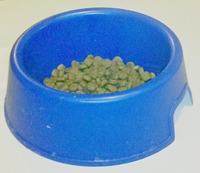
This post may contain affiliate links. We are compensated for referring customers to our affiliate partners.
 Some people like to rotate their dog’s food, either using the same brand and different formulas or several different brands. You may have wondered if this is a good idea or not. Afterall, there are a couple of dog food companies that recommend it. Here are some thoughts about this practice.
Some people like to rotate their dog’s food, either using the same brand and different formulas or several different brands. You may have wondered if this is a good idea or not. Afterall, there are a couple of dog food companies that recommend it. Here are some thoughts about this practice.
Why rotate?
Taste of the Wild and Orijen, two good dog food brands, recommend rotating your dog’s food if you feed their brands. These are both grain-free foods that are high in meat protein. According to their reasoning, when you rotate foods (among their brands, respectively – they don’t seem to encourage you to buy another company’s dog food), you will be giving your dog different amino acids, which is desirable. Amino acids are the building blocks for proteins and different meat proteins can have slightly different amino acids. Again, according to these companies, in the wild a wolf/dog would be eating different kinds of prey and thus getting many different kinds of amino acids in his diet.
Does rotating dog food prevent allergies?
Although you will find several sources on the Internet that tell you otherwise, the answer is no. As long as your dog is eating one food and not showing any signs of allergies or a food intolerance, there is no need to rotate food to “prevent” allergies. In fact, exposing your dog to the proteins in other foods can cause an allergic reaction to the new proteins. The more proteins your dog is exposed to, the more you increase the chance that your dog could become allergic to something. This is true even when you feed your dog novel proteins in expensive dog foods. Of course, it’s possible that your 10-year-old dog can suddenly develop an allergy to chicken after eating a chicken-based dog food for years but if he does, you will have lots of other good dog foods to choose for him that use other protein sources.
Should you rotate dog food to give your dog more variety?
Most dogs are happy eating the same food regularly. If you wish to add some canned food or a little homemade stew to their food to make it tastier, that’s fine, but dogs usually don’t like a lot of change. Changes in your dog’s food often lead to an upset gastrointestinal tract with diarrhea or vomiting. If you change foods often you can keep your dog’s GI tract upset on an ongoing basis which will lead to other health problems. Of course, it is possible that if you change your dog’s food continually he may get used to the changes and adapt to them, but only after a lot of upset stomachs. Some dogs will continue to have gastrointestinal problems when you change foods.
But isn’t variety good for your dog’s health?
You don’t have to stick with one dog food all the time. Most people will change dog foods for various reasons from time to time. Certainly, variety is good for your dog when you are cooking for him or providing a raw food diet where you are trying to balance out his nutrition over the course of several days. But commercial dog foods are supposed to guarantee that every meal you feed your dog provides complete and balanced nutrition if they are AAFCO-approved for adult dogs or all life stages. You should not have to feed your dog a variety of dog foods in order for him to achieve good health under these circumstances, especially if you are feeding a good quality food. This is particularly true if you are feeding a dog food that has achieved AAFCO approval through feeding trials.
On the other hand, if you are feeding a dog food that has met AAFCO approval with a nutrient profile, there can be a greater risk of nutrient excesses or deficiencies in the food. Sometimes these problems may not show up in your dog for several years. A nutrient profile is designed to show that the food looks good on paper. This is a particular problem with small boutique dog food companies which do not invest the money to do expensive six-month feeding trials. It’s also worth noting that nutrient amounts can be “off” in some grain-free foods. AAFCO and National Research Council recommendations for nutrients in dog food are based on foods made with grains. Foods with grains contain phytates that bind some of the minerals added to the food so they aren’t absorbed by your dog. Grain-free foods don’t contain phytates to bind the minerals so the foods can contain an over-abundance of some minerals that your dog can absorb. Depending on the minerals involved, this can be harmful in some cases. This could explain why some grain-free food companies have recommended rotating foods.
Doesn’t your dog need to encounter other proteins to build his immune system?
No. That’s not how the immune system works. When a puppy or dog eats proteins he won’t have an allergic reaction to the protein the first time he eats it. His body won’t react to it as an allergen at that time. If he is allergic to it, he has to encounter it again. At that time his body will have made antibodies to fight the allergen and release histamines and other chemicals which cause the allergic reaction. A dog can have this kind of reaction to lots of different things, including food ingredients. The wider the variety of ingredients you introduce to your dog, the more likely you are to encounter something he might be allergic to. Even if he is not allergic to some of the common allergens, he might be allergic to some of the less common food allergens. Any kind of protein can become an allergen. You can’t prevent allergies or immunize your dog from getting an allergy by feeding him different kinds of food. You can keep your dog healthy and try to support his immune system. A stressed or weakened immune system is more likely to show a reaction if your dog is prone to allergies. Some dogs have immune systems that are overactive or which react inappropriately.
Should you rotate dog foods?
If you are feeding your dog a food that has been approved by AAFCO for your dog’s life stage and it is a good quality food, it should be meeting your dog’s nutritional requirements. There should not be any need to rotate your dog’s food. You can also look at your dog’s weight, his skin and coat, his energy level, his eyes, and other signs to see if he looks and acts healthy. If your dog is doing well on the food you’re feeding, there shouldn’t be any need to rotate his food. In other words, don’t mess with what’s working for your dog. You might make things worse.
What if I want to rotate foods?
If you want to rotate your dog’s food you can choose another formula from the same company or choose a similar food from another company. Do not rotate too often. Your dog’s stomach needs time to adjust to eating the new food. Some people rotate every three months. Other people rotate more often but the more often you rotate the more likely you are to upset your dog’s stomach, especially if you have a breed or dog with a sensitive stomach.
Make changes in the food gradually. You can mix some of the new formula in with the old formula to make the change over the course of a few days.
Speaking plainly
I read lots of people’s comments on message boards and other places saying that their dogs have an upset stomach or they aren’t doing well on this or that food good brand of dog food. They switch from food to food constantly. Well, that could be why their dogs’ stomachs are always upset. They keep changing food. That’s not always the reason, but it often is. Dogs don’t do well when you change food that often.
I’ve been breeding and showing dogs for 25 years. I tend to find a food and stay with it for years. My dogs are healthy and live into their teens. They don’t have upset stomachs. It may not sound appetizing to us, but dogs do very well eating the same good food at every meal. Okay, it’s an old school approach but it works.

Wow. What a breath of fresh air. I just recently got off the dog food merry go round and settled on yes, Pro Plan, because my puppy has done much better on it than grain free kibble. I no longer buy into the hype that corn and by-products are the devil’s work. And changing foods for sure aggravated my dogs’ diarrhea rather than helping cure it. My last question was whether or not I *had* to rotate protein sources and your very reasonable article would suggest I don’t. Now if I want to tinker (and I’m afraid I do 🙂 I’ll just add different fresh foods to the same PP formula (in moderation): cottage cheese, yogurt, canned food, sardines, etc. Thank you!
What do animals eat in the wild? Whatever they can. Dogs will eat the poop of other animals off the ground, right after they just had a $3 can of dog food. If they can catch a rat, they’ll eat it. If they can get the leftovers from a fried fish dinner, down the hatch. I like for my dog to get variety, different sources primarily of protein, including fish, internal organs like liver, and both dry and wet food. It just makes sense.
My reason for switching my dog’s canned dog food every so often is purposely to get his stomach used to receiving different foods. Even though I keep all garbage secure, there is always the dog-lover friend or relative who wants to sneak Rover food off their plates or that piece of hot dog. Or if a person has children, they are always spilling food or dropping anything to Rover that they don’t want to eat themselves. I’ve followed this pattern for over fifty years and never had any stomach problems with my various dogs; some purebreds and some mixed breeds.